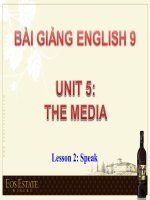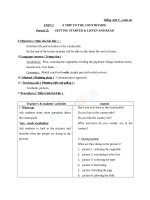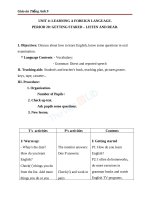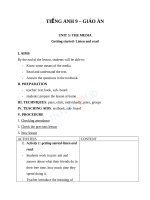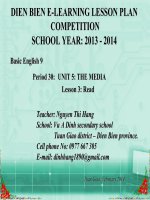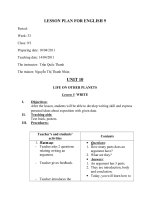giáo án tiếng anh 9 unit 5 - the media
Bạn đang xem bản rút gọn của tài liệu. Xem và tải ngay bản đầy đủ của tài liệu tại đây (103.59 KB, 14 trang )
TI NG ANH 9 – GIÁO ÁNẾ
UNIT 5: THE MEDIA
Getting started- Listen and read
I. AIMS
By the end of the lesson, students will be able to:
- Know some means of the media.
- Read and understand the text.
- Answer the questions in the textbook.
II. PREPARATION
- teacher: text book, sub- board
- students: prepare the lesson at home
III. TECHNIQUES: pairs, elicit, individually, pairs, groups
IV. TEACHING AIDS: textbook, sub- board
V. PROCEDURE
1. Checking attendance
2. Check the previous lesson
3. New lesson
ACTIVITIES CONTENT
1. Activity 1: getting started-listen and
read.
- Students work in pair: ask and
answer about what their friends do in
their free time, how much time they
spend doing it.
- Teacher introduce the meaning of
“media”
2. presentation
- Students look at the picture and
guess who he is in the picture, what
he is doing.
- Students listen.
- Teacher explains some new words.
- Read the words in choral
- Read the words individually.
- Students work in pairs: complete the
table.
- Read their answers aloud.
- Teacher and the whole class remark
and correct.
@ New words
- town crier
- shout(v)
- ring (v)
- wide (a)
- latest (a)= newest(a)
- inexpensive(a)=cheap(a)
- viewer(n)
- variety(n)
- local(a)
- channel(n)
- stage(n)
- development(n)/ develop(v)
- interactive(a)
- remote control
II.
1C 2B 3A 4D
III. Answer keys
1D 2B 3B 4A 5D 6D
IV. Answer the questions(2b)
- Students work in groups: answer the
questions in the textbook.
- Write their answers on the board.
- Remark and correct.
- Teacher gives the correct answers.
3. practice
- talk about their favorite type of media.
a. A town crier was a person whose job
was to go through City streets ringing a
bell and shouting the latest news as he
was walking.
b. It’s widely read by both teenagers and
adults.
c. People can get the latest information
and enjoy interesting and inexpensive
local and international programs in a
convenient way
d & e :Ss do themselves
4. Consolidation
- What is media?
- New words.
5. Homework
- read the text at home.
- learn new words by heat.
Prepare: speak+ listen
6. Changes
UNIT 5: THE MEDIA
Speak- listen
I. AIMS
By the end of the lesson, students will be able to:
- Know how to use tag- questions.
- Ask and answer about TV program.
- Listen and fill in missing information.
II. PREPARATION
- Teacher: text book, sub- board, tape, cassette player.
- students: prepare the lesson at home
III. TECHNIQUES: pairs, elicit, individually, pairs, groups
- IV. TEACHING AIDS: textbook, sub- board, tape, cassette player.
V. PROCEDURE
1. Checking attendance
2. Check the previous lesson
3. New lesson
ACTIVITIES CONTENT
1. Pre- speaking
- Teacher introduces tag-question.
- Give examples.
2. while- speaking
- Students read the daily TV guide.
- Work in pairs: make similar
dialogue as the modal one.
- Roles play
- Remark and correct their
TAG- QUESTION
a. to be
S+ be (not) + O, be (not)+S?
Ex: she is a nurse, isn’t she?
They aren’t expensive. are they?
b. ordinary verbs
S +V(s, es) +O, don’t/doesn’t +S?
Ex: He likes cats, doesn’t he?
S + don’t/ doesn’t +V (inf), do/does
pronunciation.
3. Post- speaking.
- Students talk about their favorite
programs.
* pre- listening
- Teacher asks students if they
know when the telephone, first
printed newspaper was invented.
* while listening
a. task 1
- Students listen to the tape.
- gets feedback.
- listen and check
b. task 2
- students listen to the tape again
- gets feedback
- listen and check.
* post listening
- talk about important dates of the
media.
+S?
Ex: they don’t want to move, do they?
c. modal verbs.
S + modal verbs (not) +V(inf), modal
verbs (not) +S?
Ex: she can swim, can’t she?
They won’t be late, will they?
• Note
I am a student, aren’t I ?
Open the door, will you?
Let’s go for a walk, shall we?
• What is Chau’s assignment
about?
• Listen and fill in the missing
information.
4. Consolidation
- tag- question
5. Homework
- Practice at home
- learn the structure by heart.
- prepare : read
6. Changes
UNIT 5: THE MEDIA
Read
I. AIMS
By the end of the lesson, students will be able to:
- Know the two sides of the Internet
- Know what their friends think about the Internet.
II. PREPARATION
- Teacher: text book, sub- board
- students: prepare the lesson at home
III. TECHNIQUES: pairs, elicit, individually, pairs, groups
IV. TEACHING AIDS: textbook, sub- board
V. PROCEDURE
1. Checking attendance
2. Check the previous lesson
- Tag questions
3. New lesson
ACTIVITIES CONTENT
1. Pre- reading
- Teacher gets students to make a
list of the usefulness and
harmfulness of the Internet.
2. While- reading
- teacher reads the text
- Teacher explains some new
words.
- Read the words in choral
self-study get information
relax
communicate
Usefu
l
- Read the words individually.
- Some students read the text aloud
- Students work in groups: answer
the questions in the textbook.
- Write their answer on the board.
- Remark and correct.
- Teacher gives the correct
answers.
- Students work in pairs: true or
false?
- Students check if these
statements are true or false.
- Read their answers aloud.
- Correction
3. Practice
Students talk about what they think
about the Internet.
tired costly
time consuming virus
@ New words
- surf (v):
- communicate(v)/
communication(n)
- available (a)
- explore(v)
- wander(v)
- purpose(n)
- commerce (n)
- limitation(n)
- time- consuming (a)
- costly (a)
- spam (n)
- electronic junk mail
- personal information leaking
- alert (a)
• Answer the questions
• True or false?
1. Sandra doesn’t like the Internet.
Harmfu
l
4. Consolidation
- Tag- question
5. Homework
- Practice at home
- learn the structure by heart.
- prepare: read
6. Changes
UNIT 5: THE MEDIA
Write
I. AIMS
By the end of the lesson, students will be able to:
- Write a paragraph about the advantages of the Internet.
II. PREPARATION
- Teacher: text book, sub- board
- students: prepare the lesson at home
III. TECHNIQUES: pairs, elicit, individually
IV. TEACHING AIDS: textbook, sub- board
V. PROCEDURE
1. Checking attendance
2. Check the previous lesson
New words
3. New lesson
ACTIVITIES CONTENT
1. Pre- writing
- Students think about what benefits
the Internet has.
- Read part 5 again.
- Make a list of benefits of the
Internet.
2. While- writing
- Students write a passage about the
benefits of the Internet
individually.
- Teacher guide them how to use
transition signals.
- Write their passage on the board.
- Remark and correct.
3. post- writing
Students talk about what they think
about the Internet.
4. Consolidation
- write at home
5. Homework
- Practice at home.
- prepare: language focus.
6. Changes
UNIT 5: THE MEDIA
Language Focus
I. AIMS
By the end of the lesson, students will be able to:
- review tag- questions
- know some verbs followed by gerund
II. PREPARATION
- Teacher: text book, sub- board
- students: prepare the lesson at home
III. TECHNIQUES: pairs, elicit, individually, groups
IV. TEACHING AIDS: textbook, sub- board
V. PROCEDURE
1. Checking attendance
2. Check the previous lesson
3. New lesson
ACTIVITIES CONTENT
1. Activity 1: complete the dialogue
with the correct tag.
- Review tag questions
Students work in pairs: complete the
dialogue with the correct tag.
- Write their answers on the board.
- Remark and correct
- Practice the dialogues in pairs.
- Roles play.
1. Activity 2: Use tag question to
TAG- QUESTION
a. to be
S+ be (not) + O, be (not)+S?
Ex: she is a nurse, isn’t she?
They aren’t expensive. are they?
b. ordinary verbs
S +V(s, es) +O, don’t/doesn’t +S?
Ex: He likes cats, doesn’t he?
S + don’t/ doesn’t +V (inf), do/does
+S?
ask about television program
these people like and dislike.
- Students work in pairs: ask and
answer.
- Roles play.
- Remark and correct
2. Activity 3: ask and answer about
each item in the box.
- Teacher introduces some verbs
followed by gerund.
- Pairs work: ask and answer
- Roles play
3. Activity 4: write true sentences
about their parents
- Students work individually: write
the sentences using these verbs.
- Wire their sentences on the board.
- Remark and correct.
Ex: they don’t want to move, do they?
c. modal verbs.
S + modal verbs (not) +V (inf), modal
verbs (not) +S?
Ex: she can swim, can’t she?
They won’t be late, will they?
• Note
I am a student, aren’t I?
Open the door, will you?
Let’s go for a walk, shall we?
* Verbs followed by gerund.
Like
Love
Enjoy +V-ing
Deny
Dislike
Hate
Ex: I like watching TV
4. Consolidation
- tag- questions
- some verbs followed by gerund
5. Homework
- Practice at home.
- prepare: revision
6. Changes
